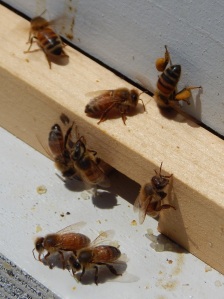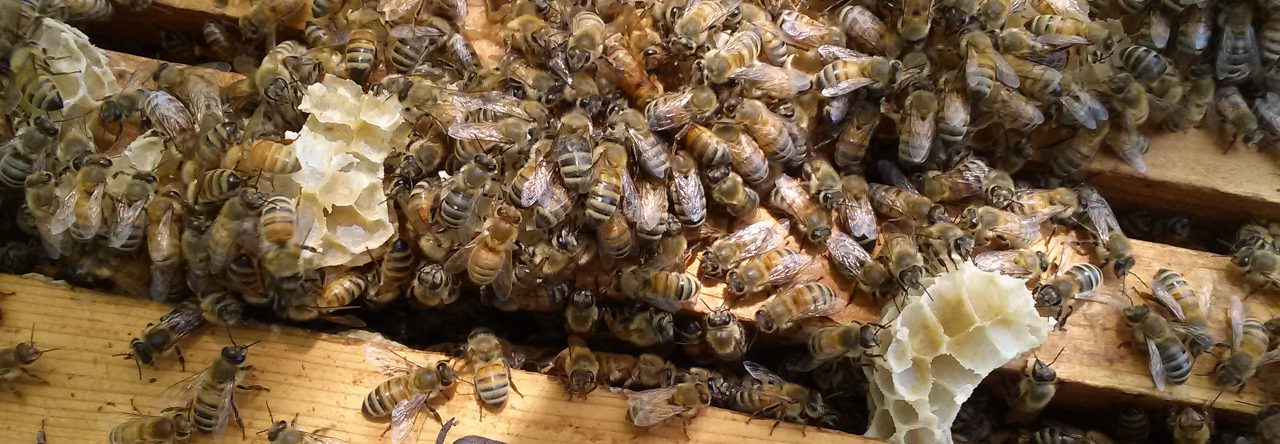Another big weekend at TheHoneyOp last Saturday and Sunday, with plenty on the agenda, including the first inspection of Hive1 and a check on the Hive2 queen…when last we left her, she was still in her cage, surrounded by angry workers who appeared to be trying to kill her.
A few of the videos below are longer than in previous posts (2-3 minutes; I think one is around 5); that’s because, as we move deeper into the season and I have more things to accomplish, I’m not always thinking about you, the viewer…don’t take it personally, but my top priority is always the bees.
That’s also why, as you’ll see, I cut short the first inspection of Hive1. The wind was pretty intense at times, and I didn’t want the bees getting blown all around, especially the queen, who is not built for flight and would have a hard time getting back home if the wind got hold of her.
That said, after closing up the hives and getting ready to leave, it was wonderful to stand off to one side and watch the foragers coming in absolutely piled up with pollen. You can see it stored in little pollen pockets, the bee equivalent of saddlebags, I suppose, on the back legs of this Hive1 forager, top right:

I also love the two guards at bottom of image, standing there like the doormen at a nightclub. I wanted to get them a teeny tiny velvet rope.
Inspection!
It was unusually warm for early Wisconsin May (my phone said 82 degrees Fahrenheit right as I arrived around 11 a.m.) and also windy. The heat is not a problem — the bees can certainly handle that, but I was concerned about the occasional gusts of wind that came through, which you can hear in some of the videos.
I was also a little concerned about my girls getting blown around in the wind since they were no longer alone in the apiary:
Where there is smoke there is not necessarily fire, which is a good thing. I got the smoker up and running and started inspection on Hive1 (which I think I call Hive2 at least once in the video). The point of an inspection is to see that the hive is “queenright” — that the queen is alive and laying eggs — and also look for signs of disease. It’s also important to check that the workers are doing what they’re supposed to be doing, which at this point is building comb (the sheets of plastic foundation have a slightly raised honeycomb pattern to guide them, but it’s up to the workers to build the cells that the queen can put eggs in and the workers can fill with nectar and other sustaining goodies).
Maybe I am easily excited, but it was very cool to see how hard the bees are working. They have built up comb on the frames in the middle of the hive, as shown below:
The results of the search for the Hive1 queen:
Okay, so I didn’t find her, but I am okay with that. I am also not totally sure I saw eggs (they’re tiny and white and hard to see against the pale background of new comb), though at one point I think I did. I didn’t go through each frame a second time because of the wind, and because the workers need to be building up the comb for the queen to have a place to lay the eggs, and I felt like every minute I spent poking around in there was time lost to them. I hope to find her, or some eggs, next inspection.
Now, that green plastic frame I was all excited about: it’s a drone frame, though I’ve heard it called a couple different things. Varroa mites are a scourge to bees and sap a colony’s strength, weakening it and introducing potentially deadly pathogens. There are a range of chemical treatments you can use to keep the mites in check (there will invariably be a few mites in a colony, the issue is not preventing them but keeping their numbers low), but all of them are toxic and several are not even that effective.
The funny thing about Varroa vermin, however, is that they prefer drones, the male bees which are larger than workers. Given the choice between drone or worker, the adult female mite will crawl into a drone cell before it’s capped to have her babies there and feed on the developing drone larva.
Enter the drone frame. Because drones are larger than workers, their cells are larger, and the green plastic frame is imprinted with a larger comb pattern. The workers following the pattern as a guide build drone-sized cells. The queen lays eggs and the workers proceed to raise a whole board of drones, hopefully attracting any mites wandering around the hive. The drone cells are then capped with the mites inside.
Then, just before the drones emerge from their cells, the beekeeper removes the drone board (replacing it with another empty one) and freezes it. Sorry, drone instars (developing larvae on the verge of emerging). Your sacrifice is for the good of the colony.
Yes, freezing kills the developing drones but it also kills the mites. You then thaw the drone board, uncap the cells, exposing the dead drones and mites and put it back in the hive, where the workers clean everything out and start the process again, probably cursing you for making more work for them.
You can also apparently feed the drone larva to chickens, who love it, so if you’re one of my local friends who keeps chickens, let’s talk…willing to barter dead drones for a few fresh chicken eggs if this whole drone frame thing goes according to plan.
Okay, back to the videos!
Before closing up Hive1, I refilled the frame feeder with more sugar syrup, drenching a bee as I did (the wind was blowing the syrup stream all around). That particular bee will be okay…in fact, she’ll be pretty popular as other workers lick her off.
Alas, I can’t say the same for too many Hive2 bees, who died the sweetest death, as you’ll see…
Release The Kraken (Or At Least The Queen)!
You can really hear the wind picking up in this video. Sorry. I do what I can with the equipment I have, and quite frankly wind is the least of my problems as you’ll see when I pop off the top cover and look into the horror that is the Feeder Of Death:
After removing the Feeder of Death, I went into the hive proper only to find the girls are way better housekeepers than I am (at least in terms of tidying up around the house). And I find the queen…
If I sound happy and a little surprised in the video above when I find the queen, it’s because I was nervous about leaving the queen in her cage for a full week. I felt it was the right call given how aggressive the other bees seemed to be toward her last weekend, but I’m new to this and everyone seemed to have a different opinion. Leading up to today, I wasn’t sure whether to manually release her, basically open the cage and let her walk right into the hive (and possibly to her death) or do a slow release, where you remove the cork and replace it with a mini-marshmallow that the workers eat through to reach her.
Before I made it back to the apiary, I made the mistake of asking which option people thought I should do on one of the beekeeping groups I follow on Facebook. Of course, people weighed in telling me all the things I had already done wrong, even things they knew nothing about. (One woman said my queen was definitely dead already, another chided me for not having two hives…hey, dumbass, I have two hives, I just didn’t mention the other hive because it was NOT RELEVANT TO MY DAMN QUESTION. Another guy said he was “very concerned” about me checking on the bees too often, another that I wasn’t checking on them enough.) Gaah! People! I eventually removed the post and quit that group, because my time is too valuable to waste on people long on opinion and short on knowledge or reading comprehension.
Anyway…
Finding the queen very much alive and the workers very receptive to her made delighted me. Take that, Facebook mob.
Here’s an up-close look at the Hive2 queen, with the bonus sound effect of my runny nose. Hey, you get what you pay for when it comes to online content. (This is the longest video from the visit, clocking in just over five minutes. It’s that long because I am focused on getting the queen back inside safely and not squishing her workers rather than producing a riveting video! I also ruminate a bit with a disturbing amount of uptalking that I really need to do something about.) I am laughing because you can’t see it but they are not happy to have me mucking about with their queen.
I said “that’s all for today” but it wasn’t…Some closeups of Hive1’s hive entrance, with foragers returning loaded up with pollen. Yeah, baby. Keep it going, girls:
I returned the next day (Sunday) to give Hive2 more food (because I didn’t expect to find the Hive2 feeder totally dry, I had given the majority of the syrup to Hive1) and consider retrieving the queen cage:
Aaaaand, one more short video (my camera battery died!) of the hive entrance with the larger opening in Hive1 to allow more foragers in and out:
Stay tuned for another inspection, this time of both hives, this weekend!
